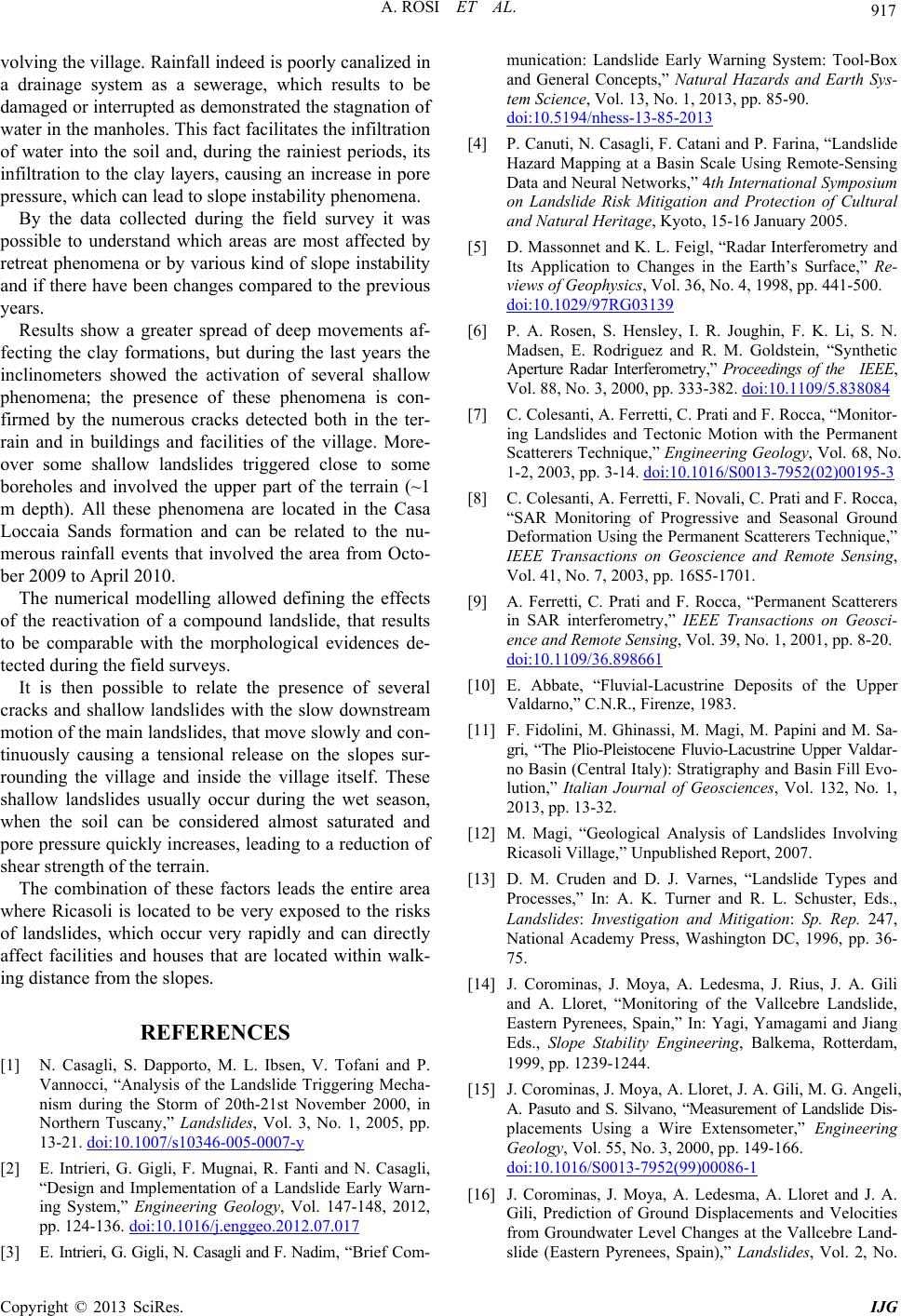
A. ROSI ET AL. 917
volving the village. Rainfall indeed is poorly canalized in
a drainage system as a sewerage, which results to be
damaged or interrupted as demonstrated the stagnation of
water in the manholes. This f act facilitates the infiltration
of water into the soil and, during the rainiest periods, its
infiltration to the clay layers, causing an increase in pore
pressure, which can lead to slope instability phenomena.
By the data collected during the field survey it was
possible to understand which areas are most affected by
retreat phenomena or by various kind of slope instability
and if ther e have been changes compared to th e previous
years.
Results show a greater spread of deep movements af-
fe
d in buildings and facilities of the village. More-
ov
es with the slow downstream
m
r during the wet season
w
lides, Vol. 3, No. 1, 2005, pp
13-21. doi:10.1007/s10346-005-0007-y
cting the clay formations, but during the last years the
inclinometers showed the activation of several shallow
phenomena; the presence of these phenomena is con-
firmed by the numerous cracks detected both in the ter-
rain an
er some shallow landslides triggered close to some
boreholes and involved the upper part of the terrain (~1
m depth). All these phenomena are located in the Casa
Loccaia Sands formation and can be related to the nu-
merous rainfall events that involved the area from Octo-
ber 2009 to April 20 10.
The numerical modelling allowed defining the effects
of the reactivation of a compound landslide, that results
to be comparable with the morphological evidences de-
tected during the field surveys.
It is then possible to relate the presence of several
cracks and shallow landslid
otion of the main landslides, that move slowly and con-
tinuously causing a tensional release on the slopes sur-
rounding the village and inside the village itself. These
shallow landslides usually occu,
hen the soil can be considered almost saturated and
pore pressure quickly increases, leading to a reduction of
shear strength of the terrain.
The combination of these factors leads the entire area
where Ricasoli is located to be very exposed to the risks
of landslides, which occur very rapidly and can directly
affect facilities and houses that are located within walk-
ing distance from the slopes.
REFERENCES
[1] N. Casagli, S. Dapporto, M. L. Ibsen, V. Tofani and P.
Vannocci, “Analysis of the Landslide Triggering Mecha-
nism during the Storm of 20th-21st November 2000, in
Northern Tuscany,” Lands.
[2] E. Intrieri, G. nti and N. Casagli, Gigli, F. Mugnai, R. Fa
“Design and Implementation of a Landslide Early Warn-
ing System,” Engineering Geology, Vol. 147-148, 2012,
pp. 124-136. doi:10.1016/j.enggeo.2012.07.017
[3] E . Intrieri, G. Gigli, N. Casagli and F. Nadim , “B r ie f C om -
munication: Landslide Early Warning System: Tool-Box
and General Concepts,” Natural Hazards and Earth Sys-
tem Science, Vol. 13, No. 1, 2013, pp. 85-90.
doi:10.5194/nhess-13-85-2013
[4] P. Canuti, N. Casagli, F. Catani and P. Farina, “Landslide
Hazard Mapping at a Basin Scale Using Remote-Sensing
ometry and
he Earth’s Surface,” Re-
Data and Neural Networks,” 4th International Symposium
on Landslide Risk Mitigation and Protection of Cultural
and Natural Heritage, Kyoto, 15-16 January 2005.
[5] D. Massonnet and K. L. Feigl, “Radar Interfer
Its Application to Changes in t
views of Geophysics, Vol. 36, No. 4, 1998, pp. 441-500.
doi:10.1029/97RG03139
[6] P. A. Rosen, S. Hensley, I. R. Joughin, F. K. Li, S. N.
Madsen, E. Rodriguez and R. M. Goldstein, “Synthetic
Aperture Radar Interferometry,” Proceedings of the IEEE,
Vol. 88, No. 3, 2000, pp. 333-382. doi:10.1109/5.838084
[7] C. Colesanti, A. Ferretti, C. Prati and F. Rocca, “Monitor-
ing Landslides and Tectonic Motion with the Permanen
Scatterers Technique,” En
t
gineering Geology, Vol. 68, No.
1-2, 2003, pp. 3-14. doi:10.1016/S0013-7952(02)00195-3
[8] C. Colesanti, A. Ferretti, F. Novali, C. Prati and F. Rocca,
“SAR Monitoring of Progressive and Seasonal Ground
Deformation Using the Permanent Scatterers Technique,”
IEEE Transactions on Geoscience and Remote Sensing,
Vol. 41, No. 7, 2003, pp. 16S5-1701.
[9] A. Ferretti, C. Prati and F. Rocca, “Permanent Scatterers
in SAR interferometry,” IEEE Transactions on Geosci-
ence and Remote Sensing, Vol. 39, No. 1, 2001, pp. 8-20.
doi:10.1109/36.898661
[10] E. Abbate, “Fluvial-Lacustrine Deposits of the Upper
Valdarno,” C.N.R., Firenze, 1983.
[11] F. Fidolini, M. Ghinassi, M. Magi, M. Papini and M. Sa-
asuto and S. Silvano, “Measurement of Landslide Dis-
gri, “The Plio-Pleistocene Fluvio-Lacustrine Upper Valdar-
no Basin (Central Italy): Stratigraphy and Basin Fill Evo-
lution,” Italian Journal of Geosciences, Vol. 132, No. 1,
2013, pp. 13-32.
[12] M. Magi, “Geological Analysis of Landslides Involving
Ricasoli Village,” Unpublished Report, 2007.
[13] D. M. Cruden and D. J. Varnes, “Landslide Types and
Processes,” In: A. K. Turner and R. L. Schuster, Eds.,
Landslides: Investigation and Mitigation: Sp. Rep. 247,
National Academy Press, Washington DC, 1996, pp. 36-
75.
[14] J. Corominas, J. Moya, A. Ledesma, J. Rius, J. A. Gili
and A. Lloret, “Monitoring of the Vallcebre Landslide,
Eastern Pyrenees, Spain,” In: Yagi, Yamagami and Jiang
Eds., Slope Stability Engineering, Balkema, Rotterdam,
1999, pp. 1239-1244.
[15] J. Corominas, J. Moya, A. Lloret, J. A. Gili, M. G. Angeli,
A. P
placements Using a Wire Extensometer,” Engineering
Geology, Vol. 55, No. 3, 2000, pp. 149-166.
doi:10.1016/S0013-7952(99)00086-1
[16] J. Corominas, J. Moya, A. Ledesma, A. Lloret and J. A.
Gili, Prediction of Ground Displacements and Velocities
from Groundwater Level Changes at the Vallcebre Land-
slide (Eastern Pyrenees, Spain),” Landslides, Vol. 2, No.
Copyright © 2013 SciRes. IJG